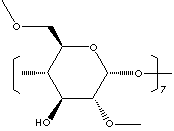| CAS
NO. |
51166-71-3 |

|
| EINECS NO. |
231-493-2
|
| FORMULA |
C64H112O40 |
| MOL
WT. |
1521.56 |
|
H.S.
CODE
|
|
|
TOXICITY
|
|
| SYNONYMS |
Dimeb; Dimethyl-beta-Cycloamylose; |
|
Dimethyl-beta-Dextrin; Dimethyl
Cycloheptaamylose;
Dimethyl Cycloheptaglucan; Dimethyl Cycloheptaglucosan; Dimethyl Schardinger beta-dextrin;
Dimethyl Cyclomaltoheptaose; Dimethyl-beta-Cycloheptaamylose; |
|
SMILES |
|
|
CLASSIFICATION
|
|
|
PHYSICAL AND CHEMICAL PROPERTIES
|
| PHYSICAL
STATE |
white powder |
| MELTING POINT |
298
- 310 C
|
| BOILING
POINT |
|
| SPECIFIC GRAVITY |
|
| SOLUBILITY
IN WATER |
Soluble |
| pH |
|
| VAPOR DENSITY |
|
|
AUTOIGNITION
|
|
|
NFPA
RATINGS
|
Health: 1 Flammability: 1 Reactivity: 0 |
|
REFRACTIVE
INDEX
|
|
| FLASH
POINT |
|
| STABILITY |
Stable under normal conditions. Light
sensitive |
|
GENERAL
DESCRIPTION & APPLICATIONS
|
|
Cyclic structure oligomers of glucose ( called cyclodextrins) are obtained from
the starch digests of the bacteria Bacillus macerans. The individual glucose
units are connected by 1,4 bonds. The most abundant cyclodextrins are alpha,
beta and gamma cyclodextrin which have 6,7 and 8 glucose units respectively. The
interior cavity is hydrophobic and the outside of the molecule is hydrophilic.
The enhanced of characteristics such as stability, aqueous solubility, and
reduced volatility, can be modified through propoxylation reactions of them.
Potential applications of cyclodextrins include water-soluble pharmaceuticals,
prolonged drug release, tabletting and herbicides and pesticides. |
| SALES
SPECIFICATION |
|
APPEARANCE |
white tpowder |
|
PURITY
|
98.0%
min
|
|
SPECIFIC
ROTATION
|
+160° ~
+165°
(c=1 in H2O on dry basis) |
| TRANSPORTATION |
| PACKING |
25kgs
in drum |
| HAZARD CLASS |
Not regulated |
| UN
NO. |
|
| OTHER
INFORMATION |
|
Hazard
Symbols: , Risk Phrases: , Safety Phrases: 24/25-28A-37-45 |
|
GENERAL
DESCRIPTION OF DEXTRIN
|
|
Dextrin is a polymeric carbohydrate which are formed during the hydrolysis of
starch to sugars by heat, by acids, and by enzymes. (Maltose, sucrose and
lactose are disaccharides of same empirical formula (C12H22O11) but are isomers
differ from in structure). Dextrin and starch have the general formula,
-[Cx(H2O)y)]n- (y = x - 1), in which glucose units are joined to one another
usually head-to-tail, but dextrin has a smaller and less complex molecule than
starch. Dextrin is soluble in water but is precipitated by alcohol.
It's chemical properties rely on the extent of the starch from which they are
derived. Some dextrin react with iodine to give a blue color and is soluble in
25% alcohol (called amylodextrin); others a reddish-brown color and soluble in
55% alcohol (called erythrodextrin); and still others yield no color at all with
iodine and soluble in 70% alcohol (called achrodextrin). It is also identified by dextrose equivalence (DE) which is a
measure of reducing power compared to the standard of 100 (dextrose). The higher
DE is the more extent of starch depolymerization. Maltodextrin is
the product of low DE. Dextrin forms a
strongly adherent paste when mixed with water and it is used as adhesive in the
manufacture of gummed tapes, textiles and paper. It is used in producing nutritional products. |
